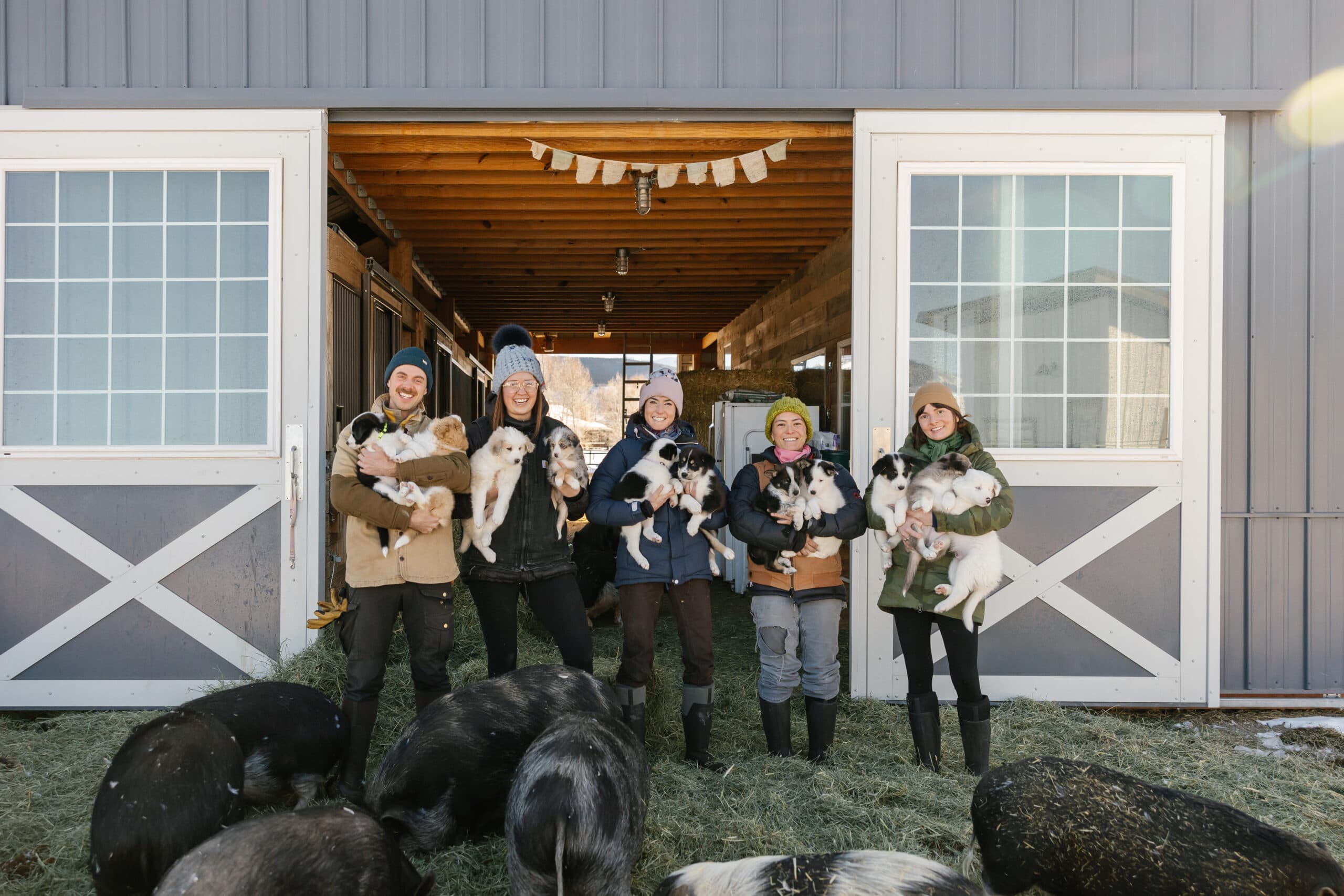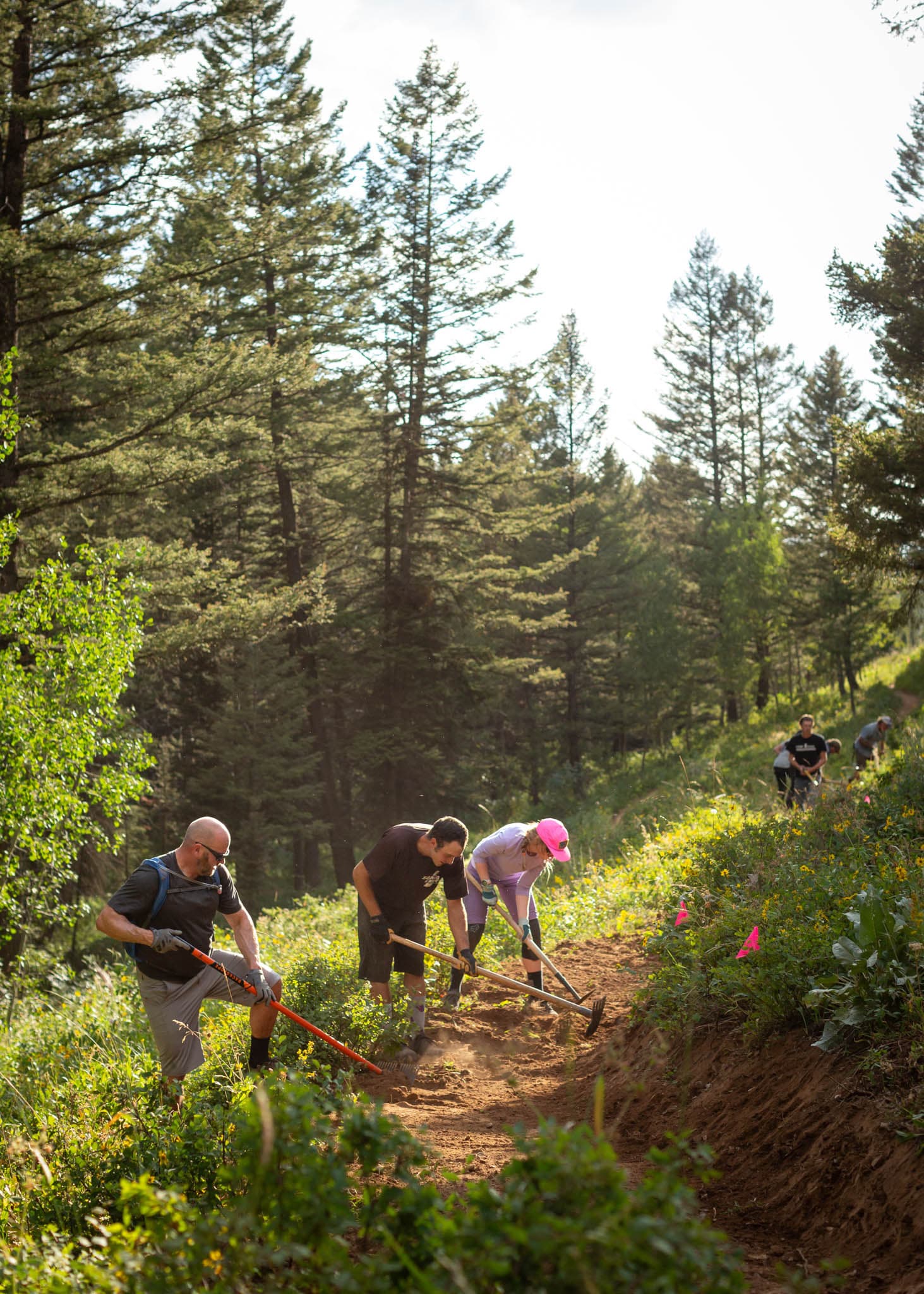Building for a Better Future
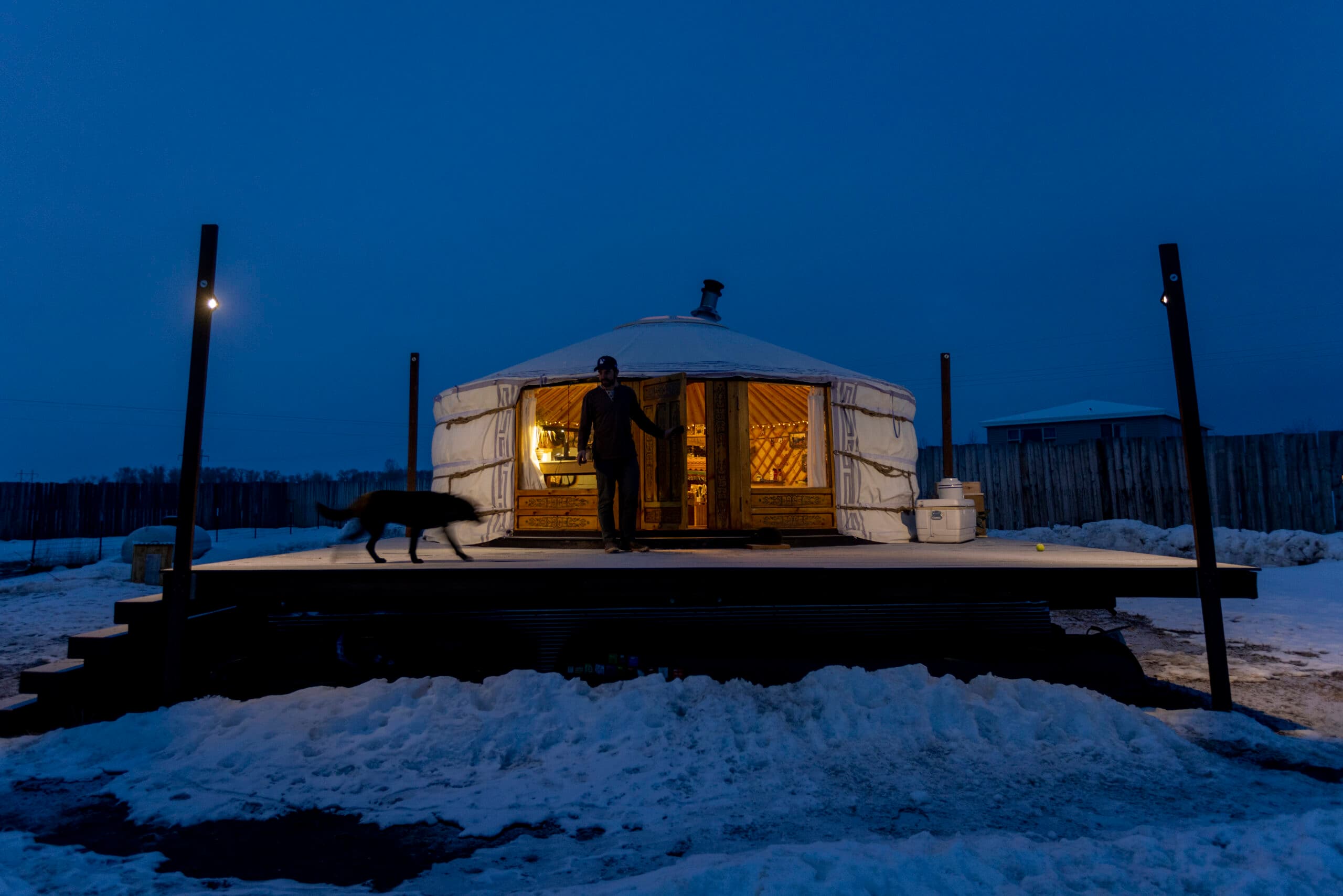
Desperate for a place to live, David and Terri Rhoades scooted their fifth- wheel camper into a cavity behind the RAD Curbside shop in Driggs this past summer. Pictures and knickknacks lent a feeling of homeyness to the small living room and kitchen; folding chairs lined a small, outdoor carpeted area where Terri could watch their Yorkie and Chihuahua mix, Star, while the pup stretched her tiny legs; the rumble of garbage trucks was their background noise.
“It’s even sad to look out the windows,” says Terri, who can’t walk far due to lingering disabilities from a car accident and spends most of her time in the camper. “I got gas silos on this side,” she says, pointing, “and dumpsters on this side.”
Without other options and with the blessing of Dave Hudacsko, owner of Teton Valley’s trash collection company RAD, they moved in temporarily behind the company’s warehouse after being forced out of their rental in February 2021. Dave fills a crucial, often over- looked role helping his employees stay in the valley. With continued unstable housing, David and Terri say, they will be forced to leave, and he will vacate that position.
Now, they find themselves in yet another temporary fix with their camper parked at Teton Valley Resort. They considered renting a house, but prices made that out of reach. “Just to rent a room and share a bathroom is a third of my paycheck,” David says. “And if you want to rent a house, I just can’t afford it.”
Their struggles with housing, reflected many times over across the valley, reveal an accelerating affordability crisis, one spurred on by recent trends but rooted in the area’s history.
“That’s kind of been the history of this place, that boom-bust cycle,” says Ralph Mossman, a glass blower and former Driggs city council member who moved to Driggs in the late 1980s. At that time, “everything was for sale,” he says, follow- ing a 1970s era of subdividing and speculation and a subsequent downturn. In the late 1990s and early 2000s, economic growth fueled more subdivisions and second-home purchasing. Responding to rising prices and limited rentals, Teton County created a Housing Authority, a governmental agency tasked with afford- able housing development.
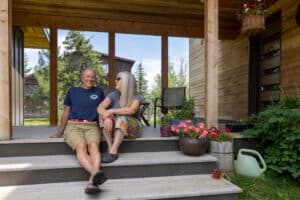
The 2008 global financial crisis, brought about in large part in the U.S. by large banks’ subprime mortgage lend- ing, brought that period of growth to a screeching halt. Recession cratered prices, opening supply and leading the Housing Authority to disband before it ever broke ground on a project.
“No one really had the foresight to keep moving forward and use that as an opportunity to acquire property and try to get a foothold really on this issue ahead of the next wave,” says Doug Self, community development director for the City of Driggs.
Jo Wildnauer wanted bigger mountains. The Vermonter moved first to Jackson in 2013, then eventually to Victor, where she found an above-garage apartment where she stayed for seven years. Her story is rare in Teton Valley, and she was likely lucky to find it, because even then the factors driving today’s housing crisis were brewing.
The 2014 Housing Needs Assessment found a 3 percent rental vacancy rate, half the recommended minimum
6 percent, and determined that over 25 percent of Teton Valley households were cost-burdened, spending at least 30 percent of their gross monthly income on housing. By 2018, rental prices had sky- rocketed 40 percent for a one-bedroom house and a whopping 137 percent for a three-bedroom (from $937 to $2,310 per month). And then the 2020 COVID-19 pandemic threw a hand grenade into Teton Valley’s housing market.
Across the country, people flocked to towns viewed as safer in the face of viral spread. With ample recreation opportunities and more amenities than many other small communities, Teton Valley was high on the list. “Rentals that we used to have where second- homeowners would have a property and they would rent it long term, a lot of those are being converted to short-term rentals,” Doug Self says. “We’ve also seen a lot of people moving into their second homes or people just relocating here.”
What he points out aren’t abstract trends. Wildnauer’s rental was stable “until AirBnB,” she says, when she joined the 18 percent of tenants who moved between 2018 and 2021 because their landlords switched to short-term renting. The owners of her house sold in December 2020 to a new couple who raised her rent significantly, from $800 to $1,300, she says. She stayed, however, but when her yearlong lease came up for renewal, she discovered they had put the main house on AirBnB and were moving into the apartment. “They never told me what they were doing,” she says. Finding a new rental became a second full- time job, she recalls.
On the home sale side, “explosive” might best describe the growth in prices, to illuminate both its trajectory and destructive nature. In 2019, the year before the pandemic, 73 percent of homes sold in Teton County, Idaho, were under
More than half of Teton Valley renters earn less than 80 percent of the area median income of $68,800.
A report from the 2018 Affordable Housing Technical Advisory Group found 370 entire home AirBnBs in Teton Valley, 6.4 percent of the housing stock, while the Teton Region Housing Needs Assessment published in March 2022 found 250 (5 percent), though that doesn’t capture the true extent of short- term rentals. Thirty percent of houses in Teton County are second homes, short-term rentals, or vacant proper- ties, totaling 1,600 abodes unavailable for permanent residents and workers, a $500,000, with 24 percent of those sales under $300,000. Just two years later in October 2021, and reported in the housing assessment, the year-to-date sales showed just 31 percent of sales below $500,000 and a paltry 5 percent lower than $300,000. For a family of three earning the area median income (AMI) of $68,800, an affordable purchase would be $343,000, meaning the market has little they can afford.
Those prices follow similar increases in construction costs and rentals, squeezing residents who fall below 200 percent of the AMI. By 2021, the rental vacancy rate was 1 percent and advertised rents for a three-bedroom were between $2,500 and $3,000, a 166 percent to 208 percent increase from 2014. A household would have to make $132,440 to afford those prices, but more than half of rent- ers earn less than 80 percent of the AMI.
Justine Wysong, who first moved here in 2007, is one of many affected by the price surge. After living in Bozeman, Montana, for awhile, she returned to be closer to her daughter’s father, who lives in the valley. Planning to build a house, Justine bought land, but stringent CC&Rs, a set of rules governing the use of a certain piece of real estate typically in a subdivision, coupled with rising building costs, make building a larger home out of reach. With construction prices around $500 per square foot, she says, a builder “quoted me $1 million for a 2,000-square-foot home.”
Wysong would like to build a house large enough for her daughter to live with her full time, but instead she bought a shipping container home and pays $800 per month to rent a space for it since her property doesn’t allow such structures. She’s lucky to have a roof over her head, she says, but “the reality is I still don’t have my daughter living with me full time.”
Shawn Hill, chair of the Teton County, Idaho, Joint Housing Authority Board, is not immune to these struggles. The former senior planner for the Town of Jackson resides in a stable, manageable rental, but he has no hope of buying a house. “Because of the combined inaction on my part and the accelerating market, I am going to have to find a less desirable place to live in the future,” he says.
Re-formed in 2019, the Housing Authority is “the entity that can maintain or manage housing for long-term afford- ability,” Teton County Commissioner Cindy Riegel says. “It’s a critical piece.” It coordinates projects and works with local governments to implement policies that encourage affordable housing development. In general, governments the size of those in Teton Valley lack the capital to build affordable projects outright, so they work with developers willing to build affordable housing, which can be harder to finance and is less profitable than market-rate building. Governments can provide tax credits, land, or the institutional clout needed to secure federal grants.
According to Hill, governmental involvement is essential to building the scale of affordable housing needed. The COVID-era factors that drove this area’s growth—working remotely, second-home purchasing, and short-term rentals—won’t disappear, so non-local demand, which accounts for a significant part of recent home sales, and resources will continue to price out locals. “The amount of outside wealth and outside capital is vast,” he says, “whereas high-amenity communities like ours are finite.”
In 2022 the Housing Authority broke ground on its first project, the Depot Square building. Slated to be move-in ready in July 2023, the building will feature thirty apartments deeded for those earning between 30 percent and 60 percent of the AMI, along with live- work units and storefronts that will, for three years, be rented to startup businesses. Though Depot Square was the only shovel-ready project as of this winter, the Housing Authority is targeting sites in Victor’s Sherman Park (seventy-two units), on Front no way we can actually get over the goal line,” says Troy Butzlaff, Housing Author- ity board member and former interim city administrator for the City of Victor.
Though the Housing Authority’s projects will provide some relief, they’re not overnight solutions. Depot Square will take several years from concept to completion by the time tenants move in. Other ideas, like forego- ing permit fees so homeowners can more easily build accessory dwelling units (ADUs) to use as rentals, have been bandied about for years, but Butzlaff says the board was waiting to hire a Housing Authority executive director before advocating those kinds of changes. In the interim, individual homeowners are left to implement ad hoc solutions.
Some, like Stacy Stamm, offer be- low-market-rate rentals, foregoing significant rental income. She and her husband, Ian Hosek, moved here in 2018 and built a house, adding an above-garage apartment that they planned to short- term rent so their friends would have a place to stay. When the pandemic start- ed, they switched it to a long-term rental and, according to Stacy, charge a price well below the average. She doesn’t see them returning to AirBnB at least until the market settles down. “We’re now in crisis mode,” she says about the valley. “We can’t morally do short term.”
Officials, and many renters, wish more landlords could approach their rentals as altruistically as Stamm. High- er home prices have forced new buyers to charge more for rent to cover mort- gages, but many renters spoke about having rents raised by landlords who have owned the houses for years and conceivably were covering their mort- gages on a lower rent.
Driggs Mayor August Christensen has tried to pioneer programs like connecting non-local second-home owners with renters for stop-gap solutions. “The city is working to mitigate rent struggles, including limited-to-no availability and homes being out of price range, by developing ways to create affordable housing for people that work in Teton Valley,” she says. “This includes new code for high density development as well as working with Teton County Joint Housing Authority.”
Other homeowners, like Aska Langman and Will Haywood, are turning to new construction, in their case with innovative materials. The couple lives in a “manufactured home,” as Aska puts it, and are constructing a stick-built house. Eventually, their current house will become a rental. However, building costs and months-long waiting times with construction companies make it difficult for many homeowners to afford to build an ADU.
Aska and Will’s situation is unique, in part because he’s in construction and was able to take six weeks off work to frame the house. They are working with architect Lindsey Love, who helped them purchase prefabricated straw-bale panels from manufacturer New Frameworks in Vermont. Using the panels allowed for overall savings in time and money. Aska and Will raised the frame much faster than if they’d used traditional building practices, and they achieve the same insulating value without less-sustainable foam-board insulation an example they hope could provide other homeowners a different option. “This is a win-win for us in terms of having the sustainability factor and the speed,” Will says.
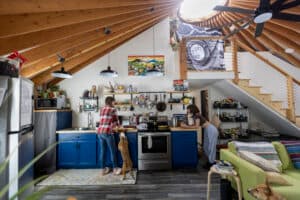
Betsy Hawkins’ yurt isn’t what you’d expect. Forget any pre- conceptions you may have of a circular single room instead, half contains an open kitchen and sitting area, while the other side boasts the framing and drywall construction of a stick-built home. With a clever layout, she tucks two bedrooms, a bathroom, and a loft into half of the roughly seven-hundred-square-foot structure.
Yurt life wasn’t what Betsy envisioned when she moved from “the hills and hollers” of Tennessee to Teton Valley, but she’s hooked. “I literally love it more than I could have ever imagined,” she says.
In 2015, she, her then husband, and their two kids moved west, allured by a desire for change. They bought a modest home in Victor, and she became executive director of the Community Resource Center of Teton Valley, a post she has since left. When she and her husband split ways in 2020, the housing market was heating up. Where she would live became a question with no easy answers.
“There really was no conversation of moving away,” she says. Builders quoted her $350,000 to $450,000 for “the tiniest, most basic box I could conceive of,” figures that were out of reach. Intent on staying, she looked for alternatives. A small apartment was an option, as was an RV, but she wanted a space her kids would enjoy, one that didn’t feel temporary. She found Shelter Designs, a Missoula, Montana, company that makes yurts capable of standing up to the area’s harsh winter weather. After she purchased a parcel of land, friends helped her stand the structure up in April 2021 through a stressful spring storm that delayed putting on the roof.
A carpenter framed in the rooms, and she had enough room for her and her two teenagers at a price she could afford. For those used to the trappings of modern life, yurt dwelling might conjure images of a scaled-back existence, but Betsy has adapted to the space. Books and a yoga mat nestle into the cavities between the studs; her butcher-block countertops and open shelves exude a modern farmhouse atmosphere. Queenie—combination guard dog and resident ham—lounges in the living room. Betsy even bakes bread in the small kitchen, utilizing it—and the yurt itself—to its fullest potential.
“I mean, I’m a cook,” she says. “I do anything and everything here that anybody else would want to do.”
At Tetonia Elementary School, Mayor Schindler says, the administration is also having trouble finding teachers because potential candidates can’t find housing, let alone afford it. That trend extends across the valley: The 2022 housing assessment found 89 percent of businesses in the valley reported being understaffed post-COVID. Many truncated hours of operation because of that chronic under- staffing, a hit to their bottom lines.
Losing that middle has another, less tangible impact. It means losing diversity of experience and many in an age group that is often dedicated to actively build- ing community. Parents and others in an age bracket typically in their thirties and forties participate in volunteer events, coach Little League, sit on nonprofit boards, and chaperone school field trips. Betsy Hawkins, former head of the Community Resource Center of Teton Valley, notes that if the only people who can afford to live here are wealthy enough to buy a house, it changes the composition of an area rooted in agriculture. “It’s too bad that we are moving away from being a well-rounded community, where you have all those things and a place for all those to fit in,” she says.
Frankie Owens, the owner of Dory’s Café and Barefoot Fitness and Pilates, has seen it all.
About a decade ago, sight unseen, save for a video tour, she signed a two-year lease on a house in Victor, rented by a family that was moving abroad. They returned early and tried to evict Frankie and her family. After an expensive legal battle that allowed her to stay until she found a new spot, the family found a rental and took everything from the previously furnished unit.
It took Frankie more than six months to find a new place. “So, we hadn’t even been in the valley a year, and we moved houses already.” They then moved into a furnished place for a year, then an unfurnished rental from a couple who moved to Colorado. Frankie asked for first right of refusal to purchase it when they sold. The couple said yes, then went dark. Letters from the bank started coming the house was in foreclosure. She had no chance to purchase and had to get out in thirty days.
Frankie was in her next place for eleven months before it sold. Then she rented directly from another out-of-state couple, then the same property through a management company, which opted not to renew her lease.
By a stroke of social media kismet, she found a four-year lease at $1,500 per month, ending years of bad luck. Unfortunately, that lease ended in 2022. She was told her rent would probably increase to $2,600 a month, a 73 percent increase. Then, the landlord told her the rent would actually be $3,200 per month, a 113 percent increase. “That, I think, is pretty darn greedy,” Frankie says.
Frankie can’t cover a down payment on a million-dollar home, nor can she find land for a tiny home, which she could afford. This past summer, however, Frankie shared a happy ending to a Teton Valley housing story. She now has an affordable rental a client of hers found.
Thirteen years. That’s how long Michele Walters felt insecure in the Teton area housing market, and that changed only because she found a benevolent landlord. Michele moved to Wyoming in 1999 to work at the Old Faithful Snow Lodge, then half of her friends moved to Jackson, where she settled, and the other half to Victor. Though she socialized in Teton Valley, the eastern side of Teton Pass fit her lifestyle at that time.
“For me, as an artist, it was a perfect spot because that’s where the clients were,” she says. It wasn’t an easy existence. “I still, you know, was a waitress, and I always had two jobs.” Her first apartment in Jackson was $450 a month, which she didn’t think was cheap back then but sounds unbelievable today.
She spent nearly a decade in Jackson, moved briefly to Victor, then headed back east over the pass for another two years. By then, however, around the late aughts, prices in Jackson were creeping higher, pushing her back to Victor, where she spent the next decade. In those years, Michelle estimates, she lived in fifteen places.
“It was exhausting,” she says of the rental churn. “It almost feels like an abandonment in some way because you just don’t have that stability. You’re constantly worried.”
After more than a decade of bouncing through rentals, she found a place she could settle in and feel comfortable. It was an apartment in Victor, and for the seven years she lived there, her landlord, a formerly struggling artist, charged a reasonable rent. “Bless his heart, he kept it low enough that I could actually start saving so I could buy a house,” she says.
Even prior to the latest explosion in home prices, that type of serendipity has often been required for the non-independently wealthy to buy a home in Teton Valley. Her landlord’s kindness ultimately allowed her to buy a place in Tetonia in 2019. It’s a live/work building in downtown that includes a space for her to live in, a small rental, and a storefront she turned into the Tribe Artist Collective, a studio and gallery space that supports twenty-five local creatives. Twenty years after moving here, after at least fifteen rentals, Michele finally has found security on her own terms.
Of her situation, she says, “You don’t understand how blessed I feel every day.”

